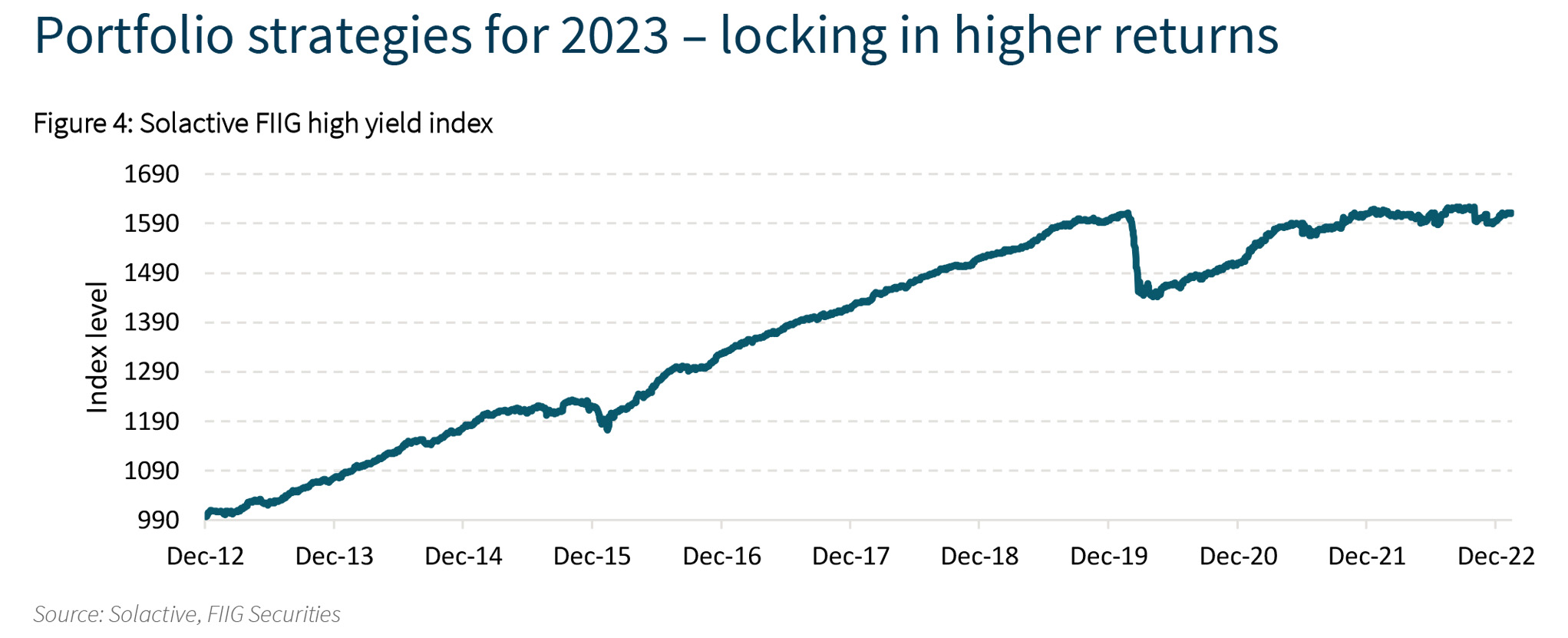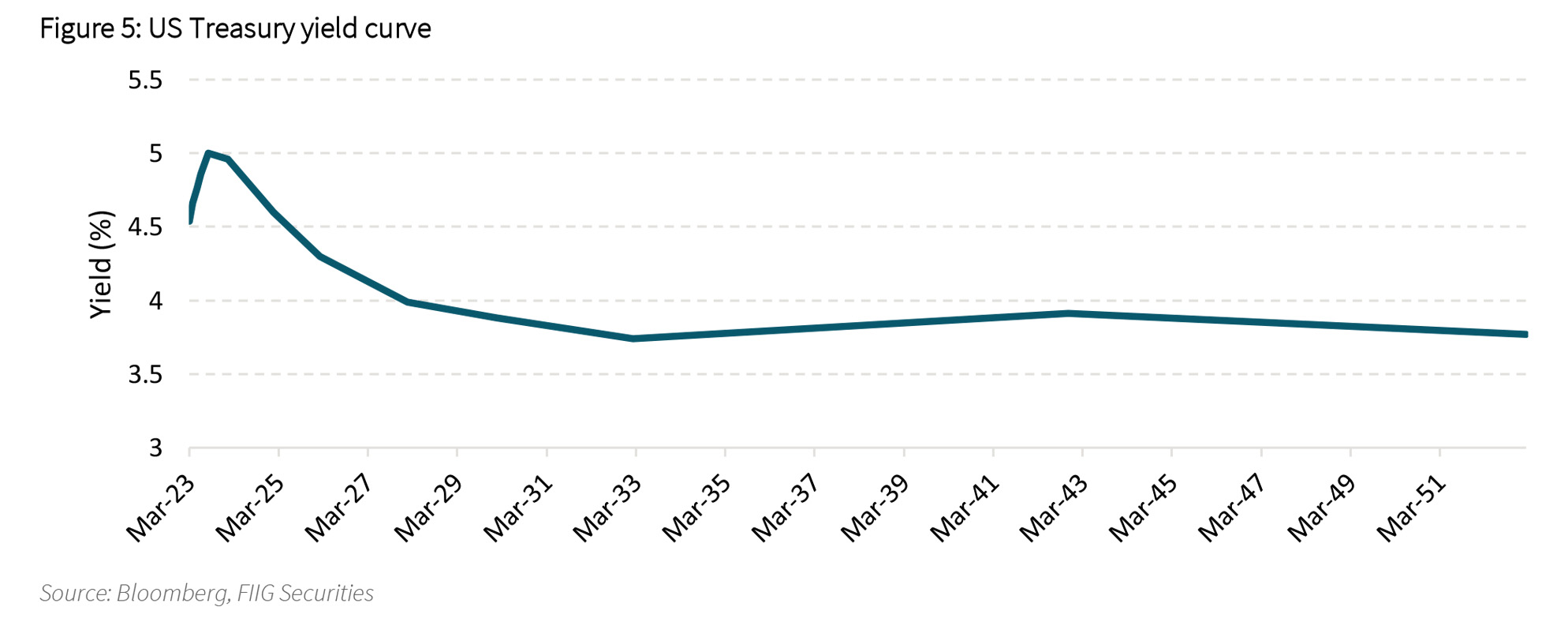Portfolio strategies for 2023 – locking in higher returns
As central banks close in on their respective terminal rates, bringing the current tightening cycle to an end this year, we look at the trading implications for 2023 and how best to position portfolios.
Background
Following aggressive rate hikes by central banks since 2022, this year should see terminal rates being reached (terminal rate is the rate at which central banks will stop hiking and will typically differ from the neutral rate, which is the rate that would deliver the perfect balance to achieve their inflation target while supporting full employment). This will anchor yields which have progressively moved higher, creating a window of opportunity to take advantage of higher returns before market conditions change.
Although current inflation both here and in the US remains elevated (locally, the December quarter CPI surprised to the upside, accelerating to 7.8%), and the Reserve Bank of Australia (RBA) has recently stated its priority is to ‘return inflation to target’, it’s largely expected hikes will end at some stage this year.
In fact, the cash rate futures market is pricing in rate cuts from September 2023, with the view that the RBA will begin cutting rates from May 2024 (at time of writing). Likewise, the Fed Funds Futures market is pricing in rate cuts from September also.
Ahead of this, the market is pricing in another two 25 basis point (bp) rate raises from the RBA in March and April, with an additional ~15bp expected in June or July. The question remains if this will reign in inflation while avoiding an economic hard landing.
It's worth noting that when it comes to bond investing, the actual terminal rate and timing of rate increases is only part of the picture when trying to lock in the best rate. The swaps curve can provide a good indication of the direction of returns irrespective of the RBA’s actual movement.
To illustrate, the 5-year swap rate recently peaked in October last year, at 4.45% (where fixed rate bonds of a similar maturity offered a higher return as a result). Markets at the time were expecting the RBA to hike to a terminal rate of 4.40%, however, it’s now expected rates will peak lower and as a result, this is driving swap rates lower. This presents an opportunity to lock in higher returns now (if you didn’t already in October).
Investment grade allocations
Fixed rate bonds
With yields higher, investment grade bonds are offering higher returns in the 5%-7% range, along with a lower risk profile. Also worth noting is that investment grade bonds have lower credit risk (the credit spread above the risk-free rate) compared to high yield bonds and typically perform better during times of economic slowdown.
With nine hikes in Australia already behind us and the RBA flagging more to come, the bulk of moves in yields has likely already taken place. We are likely also closer to the terminal rate, as Figure 1 below shows a narrowing gap between the current and market implied terminal rates (which factors in the additional three rate increases for each Central Bank for this year). Although fixed rate bonds are typically favoured in a rate cutting environment, we believe these current elevated returns offer attractive buying value.

As the market tries to predict the RBA’s next move (with even the RBA seeming unsure), we have seen yields move 10-30bp in a matter of days (and at times retrace just as quickly), which we expect to continue until the outlook becomes clearer. As such, irrespective of where yields were two days ago or will be in two days’ time, it’s key to ask: do you like the yield on offer? Akin to picking peaks and troughs of economic cycles, investors all like the idea of a better yield, but trying to time it is another thing entirely.
Better to lock-in fixed rate opportunities that present good relative value. These will provide a steady and predictable income and potentially provide capital upside if (or maybe we should say when) rates move lower. The fear of missing out on the best yield possible may result in missing out on a very solid yield currently available. As per Figure 2 below, the 10-year Australian government and US Treasury bond yields have had periods throughout 2022 of breaking through the 4.00% level, but overall have remained elevated above 3.50%. It’s worth noting (although not depicted below) that if you were an investor in late-2014 trying to time a jump in yields when the Australian 10-year government yield was ~4.01%, you would have waited 7.5 years for the yield to pop above 4.00% again (in late December 2023).

Primary markets have also offered stand out value, with new issuance reflecting these higher yields. One such example is the AAA rated Airservices Australia 2032 bond, which issued in November last year and priced at a fixed coupon of 6.00%. Another recent one is the ANZ Bank 15-year non-call 10-year subordinated note, rated BBB+ composite, which priced at a fixed coupon of 6.736%. With the market view that rate rises will end later this year, primary markets present opportunistic buying at better returns.
While short-term inflation is spiking, longer term inflation is expected to eventually fall within the RBA’s target range (with the 10-year break-even [this is the difference between the nominal yield on a fixed rate bond and the real yield on an inflation linked bond of similar credit quality and tenor] at 2.47% at time of writing), resulting in a relatively flat yield curve. The 1-year and 4-year swap rate are almost the same (also at time of writing), although noting a bond maturing in 1-year is likely to redeem in a lower rate environment, exposing an investor to lower yielding reinvestment options. As such, we see value in fixed rate bonds with maturities 4 years and longer, where there is more spread between the different maturity dates which provides additional return on offer. There is an additional ~25bps spread between the 4-year and 10-year swap rates.
Floating rate notes
Since the start of the hiking cycle, the Bank Bill Swap Rate (BBSW) has moved significantly higher, currently at 3.50% compared to 0.08% this time last year. Figure 3 below shows the 3M BBSW Forward Rates, with markets expecting 3M BBSW to reach 4.22% in 6 months and begin to taper in 9 months at 4.21%. It is set to remain above 3.50% for the sequential tenors. While the significant uplift since this time last year has translated into higher coupons on Floating rate notes (FRNs), it’s also worth noting the market pricing for rate cuts is reflected in the 3M BBSW rates.

Floating rate notes will continue to offer attractive running yields with 3M BBSW set to remain somewhat higher, although it’s noted that a good allocation to fixed rate notes will help bolster a portfolio’s cash flows. They also provide greater capital stability given they are not exposed to interest rate movement, noting the income on FRN is inherently less predictable as it will fluctuate in line with changes in BBSW.
High yield exposures
There has been less of a focus on higher yielding bonds in the current environment, largely because 6% is the new 3% in the investment grade world. But where investment grade can offer the 6% that high yield was offering two years ago, this part of the market remains an ideal way to provide incremental income, with yields on offer that can exceed 10%. The key in high yield investment remains the comfort around the credit quality of the underlying issuer.
We also believe periods of volatility and spread widening will create opportunities to add high yield bonds at improved entry points, noting as the credit spread widens, the bond’s capital price generally moves lower (all else being equal). Windows of spread widening should recover relatively quickly, as we saw across the last year, shown in Figure 4 below of the Solactive FIIG Australian High Yield Index. The Index, made up of 31 unrated issues, shows short periods of weakness quickly followed by a trend higher. It’s worth noting also, the attractive big coupons paid by high yield bonds provide a buffer to any downward price activity.

Non-AUD
With the US Federal Reserve (among other global Central Banks) hiking rates, yields on non-AUD denominated bonds have generally moved higher as well, presenting attractive returns. While we continue to see volatility in currencies, a possible strategy is rather than timing the entry, allocate a portion of the portfolio to non-AUD exposures and remain within that currency. Keeping in mind that non-AUD exposures add further diversification to portfolios and allows investors to access opportunities/issuers that aren’t offered in the Australian bond market.
While we mention the AUD yield curve is relatively flat, the US yield curve is inverted, with 2-year and 3-year yields higher than the rest of the curve out to the 2053 maturity, as illustrated in Figure 5. As such, we see value in the short-dated end of the curve (in the 2-year to 4-year tenors), which provides additional return and for a shorter investment horizon.

Conclusion
While it remains to be seen if the RBA (and other central banks) keep to their expected rate hikes for this year, a diversified portfolio is key no matter what the path entails.
Higher returns on offer from fixed rate bonds provide attractive relative value while locking in an income stream if or when interest rates mover lower. Floating rate notes in the short-to-medium term will also provide a higher running yield with 3M BBSW reaching highs over the next 6-9 months (at levels not seen since 2012),
Selective high yield exposures in smaller allocations will supplement cash flows. We also believe there is value in holding non-AUD denominated bonds, which offer diversification to portfolios.
Constructing a well-diversified portfolio, with an exposure to fixed coupon bonds, floating rate notes, high yield and non-AUD denominated bonds will remain key for investors no matter what unfolds over the year ahead.
The contents of this document are copyright. Other than under the Copyright Act 1968 (Cth), no part of it may be reproduced, distributed or provided to a third party without FIIG’s prior written permission other than to the recipient’s accountants, tax advisors and lawyers for the purpose of the recipient obtaining advice prior to making any investment decision. FIIG asserts all of its intellectual property rights in relation to this document and reserves its rights to prosecute for breaches of those rights.
4 topics

